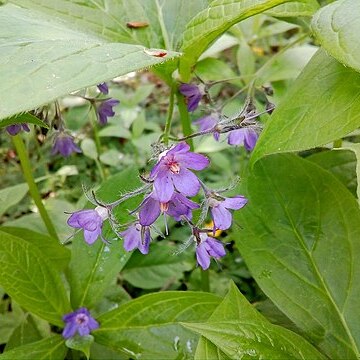Rhizomes ca. 3 mm in diam. Stems erect, not branched at apex, 30-40 cm tall, sparsely short strigose. Lower stem leaves scalelike; petiole of middle stem leaves 3-5 cm; leaf blade obovate-oblong, 2-5 cm, abaxially villous, adaxially sparsely short strigose, narrowly winged; upper 5 or 6 leaves pseudo-whorled, short petiolate, obovate to obovate-elliptic, 6-12 × 2-5 cm, abaxially sparsely short strigose, adaxially subglabrous, base cuneate, apex short acuminate. Inflorescences terminal, ca. 5 mm, densely short strigose, ca. 6-flowered, ebracteate. Pedicel 4-15 mm. Flowers crowded on upper part of rachis. Calyx ca. 8 mm; lobes subulate-lanceolate, ca. 1.1 cm in fruit. Corolla purple, ca. 1.1 cm; tube ca. 1/2 as long as limb; appendages tongue-shaped; lobes ovate-oblong, ca. 6 mm. Stamens inserted below appendages; filaments ca. 4 mm; anthers exserted, ca. 3 mm, apex mucronulate. Style ca. 1.7 mm. Nutlets 3-3.5 mm, abaxial surfaces triangular-ovate, attachment scar near base. Fl. Apr-Jun. 2n = 24.
More
A herb. It keeps growing from year to year. It grows 30-40 cm high. It has creeping rhizomes or underground stems. These are 3 mm across. It then has shoots that have an early growth like asparagus. The lower leaves are like scales. The middle leaves are like spoons. These are 9 cm long. The normal leaves are crowded neat the tips in a group of 5 or 6 and are broadly oval and 7-17 cm long by 3-8 cm wide. They taper to the tip and are wedge shaped at the base. There are a few hairs. The flowers are purple. They are 1 cm across. They occur as 3-6 in a single group. The stalks are 10 cm long. They are funnel shaped. The fruit are as 4 shiny black small nuts 3 mm long. These are 4 sided and hairy.

